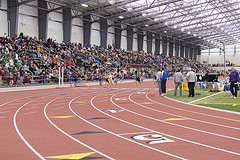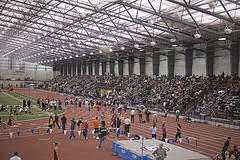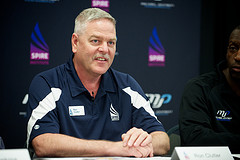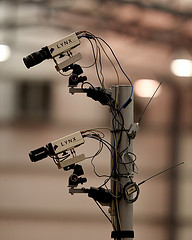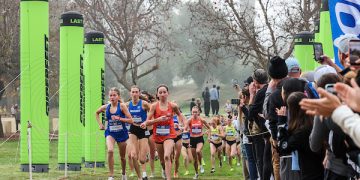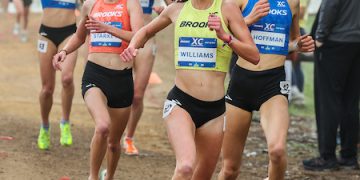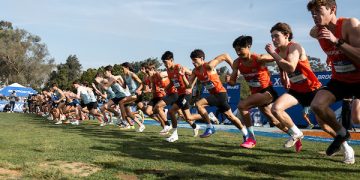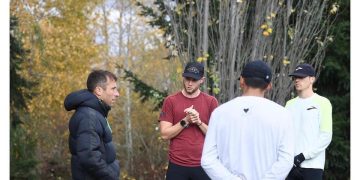The Spire Aspires To Inspire
State-Of-The-Art Facility Has Lofty Goals
Wouldn’t it be great if track & field had an incredible state-of-the art facility which featured not merely the customary outdoor accoutrements, but also a phenomenal indoor setting for running, jumping, and throwing? And what if this center also featured every cross training amenity imaginable, was linked with world class athletes, and sported an experienced and passionate coaching staff dedicated to smartly guide athletes to improved performances? And, oh, what if the facility also offered educational opportunities by virtue of its collaboration with a nearby, respected private residential secondary school? That would be great, wouldn’t it? Well, such a multi-discipline, 21st century complex exists. And where, you ask, is this complex? It is in Geneva. Not in the Alps. In Geneva, Ohio.
 Showcasing itself as “one of the largest indoor, multi-sport training and competition complexes in the world,” Spire has more than 750,000 square feet under roof with acres of surrounding outdoor facilities–all dedicated to Spire’s stated mission: “to unlock the full potential of the human spirit via athletics, academics, and service.”
Showcasing itself as “one of the largest indoor, multi-sport training and competition complexes in the world,” Spire has more than 750,000 square feet under roof with acres of surrounding outdoor facilities–all dedicated to Spire’s stated mission: “to unlock the full potential of the human spirit via athletics, academics, and service.”
The initiatives in track & field at Spire Institute are headed up by Charlie Powell, who came to Geneva about a year ago after a 30 year career at the University of Pennsylvania. With understandable pride, Powell summarizes the Spire’s most dominant attraction: its physical plant. “One of the reasons that Spire is considered one of the top national training spots for USA track & field is that it is one-stop shopping. We have unbelievable outdoor facilities and one of the best indoor facilities in the world,” Powell notes. “Indoors, we have an 8-lane 300 meter track and a 10-lane straightway. You can vault in two different areas. You can high jump in two different areas. You can run 6 throwing areas at the same time. You can long jump in two different areas. You can have all of this going on and nothing overlaps.” And with a smile, Powell adds, “We also have seating for almost 5000.”
A knowledgeable and passionate mentor, Powell outlines the basic credo that is the foundation of Spire’s philosophy. “We ask of our athletes, ‘Do you love the sport? Do you want to work to get better?’ We have kids that some through here that want to be the best kid they can be,” Powell explains. “They want to win their conference meet; to score at the state championships; or win the state championship; maybe win that college scholarship; or maybe just get into that better school.”
But Spire isn’t just about fostering the dreams of high school athletes. Established stars of the sport are also beginning to make the pilgrimage to this northeastern Ohio venue to hone their craft. Olympic gold medalists such as Jen Suhr and Jessica Beard and rising stars such as Olympians Bridget Franek and Nate Brennan have traveled to this little community near the shores of Lake Erie to escape the Great Lakes’ unforgiving winter weather and to work out in this incomparable facility. And the collegiate forces have also taken note. Later this winter the Spire will be hosting the indoor championship meets for the Big East, the Big Ten, and the NAIA.
Spire’s focus is not limited to a sport-specific approach. Reflecting its collaboration with the men’s 400 meter world record holder, Spire offers an array of assessment, speed, strength, and conditioning programs under the umbrella of Michael Johnson Performance–all of which is calculated to prepare the athlete for stepped-up performance in the particular event or sport of choice. “How can you not get better when you are training in a facility like this?,” asks Powell. “You’ve got the people, the personnel, the expertise, and the facilities that are second to none. As far as conditioning, weight training, speed and agility training, power development, it is phenomenal.”
As Spire’s long term viability is assessed, the obvious question–the elephant in the room–pertains to its economic sustainability. Does Spire Institute have the fiscal strength, the economic sustainability to survive, to thrive, to realize its ambitious dreams?
Spire CFO Jeff Orloff responds with an unequivocal “yes” when asked if Spire is on sound financial footing. “At this point, it [Spire’s financial performance] is really not something we discuss openly,” explains Orloff. “We are a viable business. As a 501(c), any profits we make go right back into the business to build dorms, to address expenses, or to address anything else that we are doing. We have several different forms of revenue. We have the Academy which is for 9th through 12th grade, plus a post graduate year. And we have those students on site, approximately 40 right now, and we’ll continue to double that number each year for the next 3 to 4 years,” notes Orloff. “We have major events here–Big 10, Big East track & field championships, Atlantic 10 swimming and diving championships, MAC volleyball championships, and on and on. We also have a lot of tournaments relating to swimming and volleyball.”
from a nomadic group of athletically-gifted high school and post-graduate students or from collegiate sports leagues seeking venues for championship meets. More likely, something larger, more consistent will be required–perhaps some type of collaboration with a sports-oriented partner who can deliver significant patronage and revenues on a consistent basis. And it appears Spire leadership, aware of this, is making progress in that direction. “We will do a number of different partnerships as they make sense–from a medical player, to different sanctioning bodies, to whatever makes the most sense, relates to what we are doing, helps us grow, and helps the community and the region,” notes Orloff. “There are a lot of exciting things that are coming up in the next 6 months, depending upon how they play out, that will help us grow significantly and help us continue to be the kind of unique facility that we feel we are.”
Once the overwhelming initial impression of the Spire is overcome, it is easy to appreciate that Spire Institute–as impressive as it is–still has vast, yet-untapped potential. The Spire could serve as an exceptional venue for a high-profile indoor meet of Grand Prix or Diamond League quality. Such a development would represent the Phoenix-like return of the type of top-flight Midwestern indoor track event that would, at long last, make elite track & field viewing once again accessible in the heartland. It is also not inconceivable that the Spire could collaborate with one of the sport’s governing bodies or large corporate sports supporters to further develop and advance the Spire into a bona fide national training center. These visions are not lost upon Spire leadership. “He has a three or four prong attack,” says Powell as he references Clutter and his long-range vision. “He wants this to be a top-level, high-class events type of place. But he also wants it to be a world leader in education and athletics combined. And there are different avenues we are pursuing to secure those two goals,” explains Powell. “Let’s put it this way,” Powell coyly reveals. “There a lot of things in our plans and the direction we go will depend upon a couple of things that may or may not happen in the next couple of months.”
Track & Field in America is long overdue for the type of multi-faceted, comprehensive complex that the Spire Institute currently is. And as magnificent as it is today, Spire clearly has the potential to evolve into an even more impressive and useful sports incubator in the future. Spire’s vision to establish itself as a premier multi-sport development and competition venue calculated to advance athletic performance across the board is ambitious, to be sure. And Spire Institute undoubtedly must clearly demonstrate that it has established a viable business model which renders it sustainable in the long run. But Spire’s vision is comprised of several components–each of which should be viewed as achievable. And if any combination of those visionary goals can be reached, it would be a wonderful development–an important step forward–for track & field in this country.
Dave Hunter


